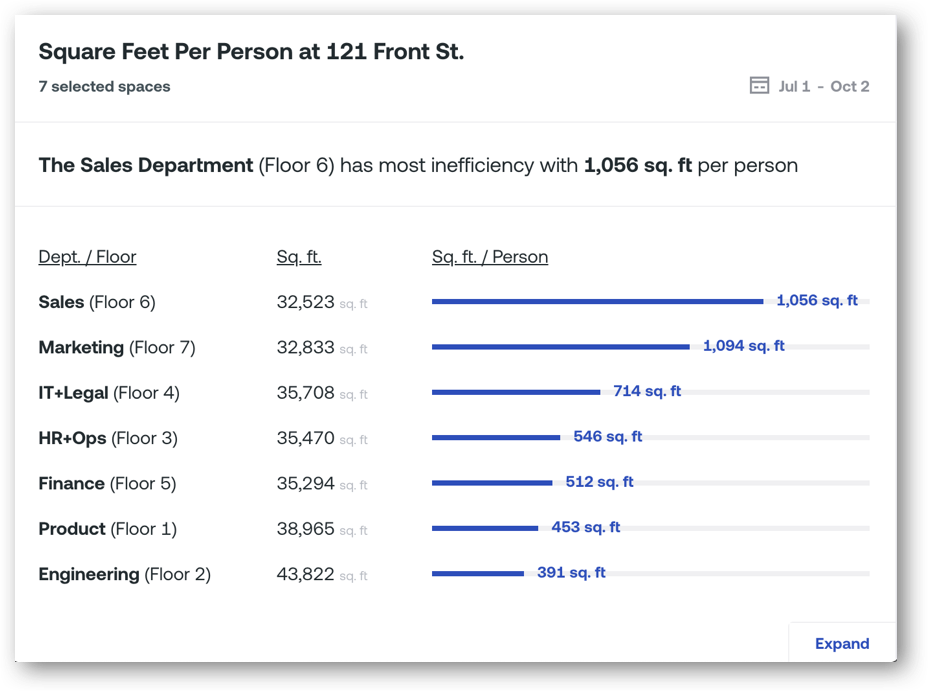Commercial real estate is regularly measured by the key metric: square feet per person.
The average square footage per U.S. office worker has been steadily declining as real estate costs rise and open offices are replacing private offices and cubicles.
In 2010, companies averaged 225 square feet per employee. By 2017, that average was 151 sq ft. Numbers for collaborative spaces are even smaller, as little as 60 to 80 square feet per person.
Tip: If you’re in the market for commercial real estate, remember to add up to 20% to your immediate square footage requirements. This will address any future growth your company realizes (saving you from having to terminate a lease early, which is costly).
Why the square footage calculation is outdated
Square foot per employee is calculated with a simple equation: the usable square feet of space a company leases or owns divided by the number of employees assigned to each respective space: X square feet divided by Y employees.
Companies assign certain employees to the buildings, floors, or areas where their teams work. The more senior an employee, the more square feet they’re (usually) designated.
For decades, this approach seemed to accurately measure the average space employees use (and need).
The problem is, that the modern workforce is far more dynamic than it once was.
Remote work is more common than ever and office spaces reflect this difference. The amount of space required for an office is no longer a hard formula counting space for individual workstations, but rather a combination of common areas, collaborative meeting rooms, and flexible spaces.
The modern office must account for a variety of workspaces and forms of work including:
- Work from home
- Coworking
- Hot desks
- Versatile meeting spaces
None of these use cases are predictable. The average office employee’s work schedule (and habits) look far more flexible today than ever before.
A simple calculation no longer suffices.
What happens to the ‘X square feet divided by Y employees’ rule of thumb? The whole equation breaks down.
Variable attendance and changing work patterns destroy the old method of calculating square feet per employee. No wonder 40% percent of global corporate real estate sits empty. This underutilization of office space is due in part to the rapidly changing way we work in offices. It’s also a result of inefficient and inexact approaches to how we calculate commercial space requirements.
Using data — not guesswork — to calculate space needs
Knowing how space is actually used can help you maximize your real estate portfolio and revolutionize your approach to office design. You have a vision of how your work environment looks and data can help define those design decisions.
Knowing your headcount and plugging it into an office space calculator is no longer adequate for assessing space needs. Data and analysis are the only ways to answer the following questions.
- Do you have enough open space for your common areas and conference rooms?
- Do you have a reception area and break room space adequate for the number of employees?
- Does your office plan match the flexible needs of your employees with the right amount of space for the areas they actually will use?
Innovative workplace strategists use historical and real-time data to analyze exactly how much — and what kind of — space per person each employee needs.
With this data, companies realize more value from their existing real estate portfolio, know when new office space is needed, and increase employee productivity and happiness.
Below are two examples.
Calculating how much space is actually used in a Fortune 1000 company
One of our Fortune 1000 customers operates nearly 288,440 sq ft of real estate and employs 1,800 people. When using the traditional calculation, they concluded that they allotted an average of 160 sq ft per employee.
That’s in line with overall market trends.
However, they weren’t satisfied with the guesswork approach to this calculation. So, they installed occupancy sensors to get a data-backed measure of the actual amount of space used by their employees. They realized the average square foot per employee was actually 603 sq ft and briefly during peak times did the average square foot per employee dropped to 310.

Even then, the number was still 93% higher than their initial estimation. Using this data, this F1000 company was able to redesign its floor plan and optimize its existing space.
Measuring true space allocation in a tech startup
A startup company used Density to measure space allocation across its different teams. The teams were predominantly distributed by different floors ranging from 32,523 sq ft to 43,822 sq ft. Our data revealed that the company’s sales team was inadvertently allocating 1,056 sq ft per employee while the engineering team was allotted 391 sq ft per employee.

This discrepancy in the amount of office space used across teams can hinder workplace productivity.
An engineer testing product quality may need to take up more than the assigned sq ft allotted to her role.
Meanwhile, a salesperson may regularly take meetings in phone booths, conference rooms, or even offsite locations like restaurants or co-working spaces — meaning they may need less space than is allotted to them.
Our data helped our client make changes to their office layout to ensure a more evenly (and flexible) approach to space allocation.
Workplace managers use sensor data to make safer, more cost-effective decisions about their space. Of course, sensors aren’t the only tech solution for measuring occupancy.
Read our free buyer’s guide that compares the most popular solutions for workplace analytics and utilization here.
